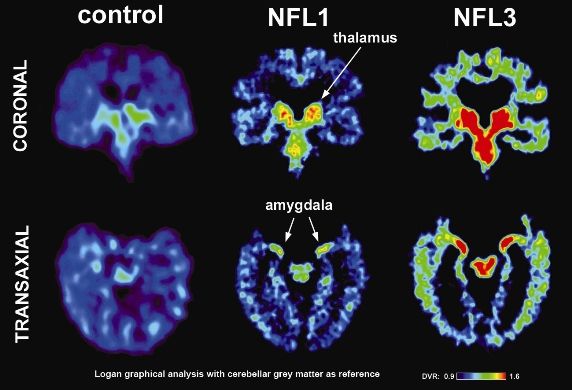FDDNP-PET Shows Brain Injury in Former NFL Players
PET imaging with a chemical marker called FDDNP has identified abnormal tau proteins among former professional football players.
PET imaging with a chemical marker called FDDNP, originally developed to look for brain plaques associated with Alzheimer’s disease, has identified abnormal tau proteins among former professional football players, say researchers in a study in the February 2013 issue of the American Journal of Geriatric Psychiatry.
“Early detection of tau proteins may help us to understand what is happening sooner in the brains of these injured athletes,” lead author Dr. Gary Small said in a release. Small is UCLA’s Parlow-Solomon Professor on Aging and a professor at the Semel Institute for Neuroscience and Human Behavior at UCLA. “Our findings may also guide us in developing strategies and interventions to protect those with early symptoms, rather than to try to repair damage once it becomes extensive.”
Five retired National Football League players, ages 45 to 73 who played professionally for 10 to 16 years, participated in the small study. The subjects had histories of cognitive or mood symptoms and diagnoses of mild cognitive impairment, dementia, depression and normal aging.
The subjects received intravenous injections of FDDNP and then underwent positron emission tomography brain scans. Their scans were compared to men of comparable age, education, body mass index, and family history of dementia.
Results showed that the football players had higher levels of FDDNP in the amygdala and subcortical regions of the brain, which was even higher among those with the most concussions, compared with the normal scans. “The FDDNP binding patterns in the players’ scans were consistent with the tau deposit patterns that have been observed at autopsy in CTE [chronic traumatic encephalopathy] cases,” said study author Dr. Jorge R. Barrio, a professor of molecular and medical pharmacology at the David Geffen School of Medicine at UCLA.
Barrio pointed out that elevated FDDNP has been associated in studies with cognitive symptoms in normal aging, mild cognitive impairment, and dementia. Currently, FDDNP is the only imaging marker that can measure tau in living humans.
The players were also evaluated for depression and cognitive ability, and the results were compared with the normal group. The players showed more depression, as well as cognitive loss. Three players had mild cognitive impairment, one had dementia, and another had normal cognitive function.
The authors acknowledge that this is a small study, but Small pointed out that a recent study of more than 3,400 retired professional football players showed evidence of a higher-than-average risk of death from Alzheimer’s disease. More research is needed to better understand the issue, they said.

Caption: The left image shows a normal brain scan and middle and right images show scans of pro football players from the study. The green and red colors demonstrate the higher level of tau protein found in the brain. Note the higher levels (more red and green) in the players’ scans. Scans of the players in the study reflect differing levels of tau protein and follow a pattern of progression similar to the tau deposits that have been observed at autopsy in CTE cases. (Credit: UCLA)
Can Abbreviated MRI Have an Impact in Rectal Cancer Staging?
April 4th 2025Abbreviated MRI demonstrated a 95.3 percent specificity for rectal cancer and provided strong agreement with the full MRI protocol for T staging and detection of extramural venous invasion, according to newly published research.
The Reading Room Podcast: Current Perspectives on the Updated Appropriate Use Criteria for Brain PET
March 18th 2025In a new podcast, Satoshi Minoshima, M.D., Ph.D., and James Williams, Ph.D., share their insights on the recently updated appropriate use criteria for amyloid PET and tau PET in patients with mild cognitive impairment.
GE HealthCare Debuts AI-Powered Cardiac CT Device at ACC Conference
April 1st 2025Featuring enhanced low-dose image quality with motion-free images, the Revolution Vibe CT system reportedly facilitates improved diagnostic clarity for patients with conditions ranging from in-stent restenosis to atrial fibrillation.










